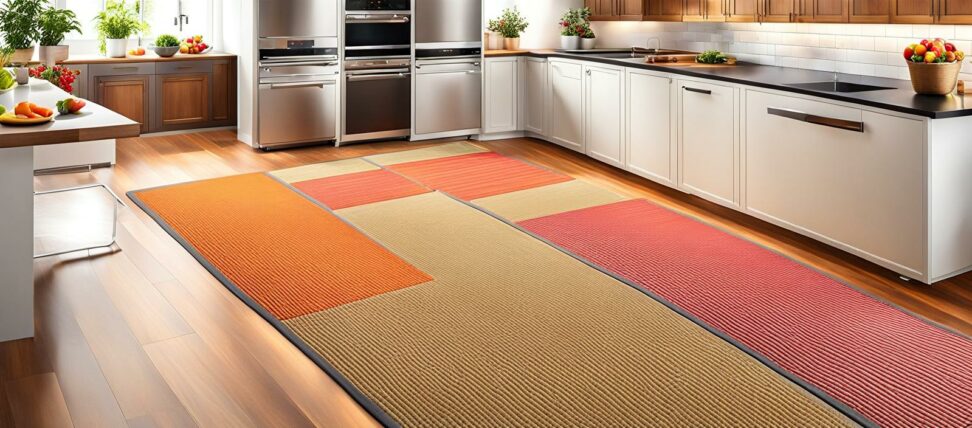Make Your Kitchen Safer With Non Slip Runners
Slipping and falling in the kitchen can lead to painful and dangerous accidents. However, you can prevent these with the help of non slip kitchen runners. These handy floor coverings add much-needed traction and create a safer cooking environment.
With cushioned comfort underfoot and slip-resistant backing, runners keep you steady in high traffic areas. Read on to learn why non slip runners are a must for any kitchen along with tips for choosing and using them.
Why You Need Non Slip Kitchen Runners
Smooth tile, wood, or linoleum can spell disaster when liquids are spilled. Grease drips, water splashes, and even small amounts of moisture quickly turn floors slippery. Attempting to cook or carry items across a slick surface puts you at risk of falling.
Runners transform potentially hazardous spaces with grip and traction. The textured underside grips the floor while the top stays firmly planted. This prevents sliding when you step or pivot.

Prevent Slips and Falls
When your kitchen has non slip runners in accident-prone zones, you can go about prepping, cooking, and cleaning with confidence. Spills happen, but runners keep floors stable so you can work safely.
Mats and runners become even more essential if children or elderly family members use the kitchen. Preventing slips protects high-risk individuals.
High Traffic Areas Prone to Slips
Runners excel at covering long spaces that see a lot of foot traffic. Areas like in front of the sink, stove, and major appliances tend to get wet and necessitate a non slip surface.
Transitions between countertops and prep areas are other danger zones. Runners create a safe path as you move about cooking and carrying items.
Provide Safety For Kids and Elderly
Children are eager little helpers in the kitchen but prone to spills and accidents. Non slip runners provide stability for kids underfoot, letting them lend a hand safely.
For elderly users, runners address key safety concerns. Trip and fall risks increase with age. Runners ensure seniors keep steady footing in their kitchens.
Choosing the Best Kitchen Runners
With a wide variety of kitchen runners available, select carefully to find the best fit. Measure your space, consider materials and features, and choose a style you love.
Size and Dimensions
First, bust out the measuring tape! Runners work best when sized to your specific high-traffic areas.
Standard sizes like 3-5 feet strips allow flexibility. Leave an extra few inches of width and length to prevent edging.
Material and Construction
Rubber, vinyl, cotton, and microfiber runners each have pros and cons. Rubber withstands heavy use but can lack cushioning. Microfiber feels lush but requires frequent washing.
Consider surface textures like nubbyBottom vs. smooth. Sticky backings attach well but suction cups lift easily for cleaning.
Style and Design
From traditional patterns to vivid colors, myriad design options exist. Choose hues and prints that will look beautiful against your cabinetry and counters.
Match contemporary décor with solids and abstract shapes. Go for farmhouse florals or plaids to complement a cozy aesthetic.
Comfort and Cushioning
Runners with thick, plush padding make standing at counters and sinks much kinder. Seek out soft foam backings for tired feet.
Your choice comes down to the right balance of comfort and support. Too much cushioning can become tiring as well.
Easy to Clean
Kitchen spills are inevitable, so pick a material that cleans up easily. Rubber and vinyl wipe clean with soap and water.
If choosing a fabric like cotton, go for stain-resistant material. Check if your runner is machine washable or requires spot cleaning.
Brand Recommendations
Quality brands like Gorilla Grip and GelPro excel at kitchen runners designed to last. Closely compare features and reviews.
Budget-friendly but effective options from Truweo and Amazer grip well too. Just ensure adequate padding and stain resistance.
Using Your Kitchen Runners
Once you’ve selected the perfect kitchen runners, use them properly for optimal safety and longevity.
Placement Tips
Focus on high-traffic zones first, like near the sinks, stove, and fridge. Also use runners as connecting pathways between workstations.
Place runners with plenty of extra space—don't just cover the danger zone. This prevents slipping at the edges.
Prevent Bunching and Curling
It’s frustrating when runners inch out of place, bunch up, or curl at the corners. Anchor them well and use rug tape or double-sided tape on the edges.
In high-moisture areas, regularly lift and smooth runners back into position as needed.
Cleaning and Maintenance
Vacuum kitchen runners frequently to remove dirt, crumbs, and debris that can be slippery. Deal with spills ASAP using the proper cleaning method.
Check your runner's tag to see if machine washing is recommended or if spot cleaning is best. Harsh chemicals may degrade grip.
Boosting kitchen safety is easy with the help of non slip runners. They provide extra traction in accident-prone areas and cushion feet against hard floors.
Choose the right size, material, and style for your space. Place them wisely, care for them properly, and enjoy cooking with confidence again.